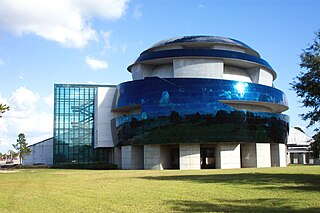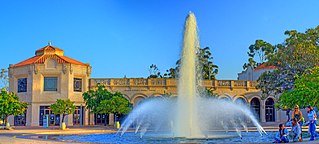
Davenport is a city in and the county seat of Scott County, Iowa, United States. Located along the Mississippi River on the eastern border of the state, it is the largest of the Quad Cities, a metropolitan area with a population of 384,324 and a combined statistical area population of 474,019, ranking as the 147th-largest MSA and 91st-largest CSA in the nation. According to the 2020 census, the city had a population of 101,724, making it Iowa's third-most populous city after Des Moines and Cedar Rapids. Davenport was founded on May 14, 1836, by Antoine Le Claire and named for his friend George Davenport.

To Fly! is a 1976 American short docudrama film directed by Greg MacGillivray and Jim Freeman of MacGillivray Freeman Films, who wrote the story with Francis Thompson, Robert M. Young, and Arthur Zegart. It premiered at the giant-screen IMAX theater of the National Air and Space Museum, which opened to celebrate the United States Bicentennial. The film chronicles the history of aviation in the US, with a narration written by Thomas McGrath. Thematically, it explores the search for national identity through the country's westward expansion as well as humanity's relationship with aviation.

IMAX is a proprietary system of high-resolution cameras, film formats, film projectors, and theaters known for having very large screens with a tall aspect ratio and steep stadium seating, with the 1.43:1 ratio format being available only in few selected locations.

Pacific Science Center is an independent, non-profit science center in Seattle with a mission to ignite curiosity and fuel a passion for discovery, experimentation, and critical thinking. Pacific Science Center serves more than 1 million people each year at its campus adjacent to Seattle Center, at the Mercer Slough Environmental Education Center in Bellevue, Washington, and in communities and classrooms across the state of Washington.

The National Museum of Natural History is a natural history museum administered by the Smithsonian Institution, located on the National Mall in Washington, D.C., United States. It has free admission and is open 364 days a year. In 2022, with 3.9 million visitors, it was the most-visited museum in the United States.

The Museum of Science & Industry (MOSI) is a non-profit science museum located in Tampa, Florida.

Fernbank Museum of Natural History, in Atlanta, Georgia, is a museum that presents exhibitions and programming about natural history. Fernbank Museum has a number of permanent exhibitions and regularly hosts temporary exhibitions in its expansive facility, designed by Graham Gund Architects. Giants of the Mesozoic, on display in the atrium of Fernbank Museum, features a 123-foot (37 m) long Argentinosaurus, the largest dinosaur ever classified; as well as a Giganotosaurus. The permanent exhibition, A Walk Through Time in Georgia, tells the twofold story of Georgia's natural history and the development of the planet. Fernbank Museum has won several national and international awards for one of its newest permanent exhibitions, Fernbank NatureQuest, an immersive, interactive exhibition for children that was designed and produced by Thinkwell Group. The awards NatureQuest has won include the 2012 Thea Award for Outstanding Achievement for a Museum Exhibit and the 2011 Bronze Award for Best Museum Environment from Event Design. The nearby Fernbank Science Center is a separate organization operated by the DeKalb County Board of Education and is not affiliated with Fernbank Museum of Natural History.

The Science Museum of Minnesota is an American museum focused on topics in technology, natural history, physical science, and mathematics education. Founded in 1907 and located in Saint Paul, Minnesota, the 501(c)(3) nonprofit institution has 385 employees and is supported by volunteers.

The New England Aquarium is a nonprofit organization located in Boston, Massachusetts. The species exhibited include harbor and northern fur seals, California sea lions, African and southern rockhopper penguins, giant Pacific octopuses, weedy seadragons, and thousands of saltwater and freshwater fishes. In addition to the main aquarium building, attractions at Central Wharf include the Simons Theatre and the New England Aquarium Whale Watch. More than 1.3 million guests visited the aquarium each year prior to the outbreak of the COVID-19 pandemic.

The California Science Center is a state agency and museum located in Exposition Park, Los Angeles, next to the Natural History Museum of Los Angeles County and the University of Southern California. Billed as the West Coast's largest hands-on science center, the California Science Center is a public-private partnership between the State of California and the California Science Center Foundation. The California Natural Resources Agency oversees the California Science Center and the California African American Museum. Founded in 1951 as the "California Museum of Science and Industry", the Museum was remodeled and renamed in 1998 as the "California Science Center". The California Science Center hosts the California State Science Fair annually.

The Fleet Science Center is a science museum and planetarium in Balboa Park, located in San Diego, California. It is at the east end of the El Prado Drive walkway, next to the Bea Evenson Fountain and plaza in central Balboa Park.

The Denver Museum of Nature & Science is a municipal natural history and science museum in Denver, Colorado. It is a resource for informal science education in the Rocky Mountain region. A variety of exhibitions, programs, and activities help museum visitors learn about the natural history of Colorado, Earth, and the universe. The 716,000-square-foot (66,519 m2) building houses more than one million objects in its collections including natural history and anthropological materials, as well as archival and library resources.

The Houston Museum of Natural Science is a natural history museum located on the northern border of Hermann Park in Houston, Texas, United States. The museum was established in 1909 by the Houston Museum and Scientific Society, an organization whose goals were to provide a free institution for the people of Houston focusing on education and science. The museum complex consists of a central facility with four floors of natural science halls and exhibits, the Burke Baker Planetarium, the Cockrell Butterfly Center, and the Wortham Giant Screen Theatre. In 2022, the museum received 1,520,000 visitors, making it seventh on the List of most-visited museums in the United States, and was the third most-visited U.S. science museum. Much of the museum's popularity is attributed to its large number of special or guest exhibits.

The Museum of Discovery and Science is a museum focused on science located in Fort Lauderdale, Florida, United States.

The New Mexico Museum of Natural History and Science is a natural history and science museum in Albuquerque, New Mexico near Old Town Albuquerque. The Museum was founded in 1986. It operates as a public revenue facility of the New Mexico Department of Cultural Affairs.

The Rochester Museum & Science Center (RMSC) is a museum in Rochester, New York, dedicated to community education in science, technology and local history. The museum also operates the Strasenburgh Planetarium, located next to the museum, and the Cumming Nature Center, a 900-acre (3.6 km2) nature preserve near Naples, New York. The museum resides at 657 East Ave. and has a collection of 1.2 million artifacts.

Gujarat Science City is a science education and entertainment centre located in Ahmedabad, Gujarat, India. Opened in 2002 and expanded in 2021, it has an IMAX 3D theatre; exhibitions on science, space, energy park, life science park, planet earth, hall of science, musical fountain, thrill ride, plants, nature and robotics; an aquarium, an aviary and a butterfly park; as well as other facilities.

The Fort Worth Museum of Science and History is located on 1600 Gendy Street, Fort Worth, Texas 76107 in the city's Cultural District. It was opened in 1945 as the Fort Worth Children's Museum and moved to its current location in 1954. In 1968, the museum adopted its current name. Attractions at the museum include the Noble Planetarium, the Omni Theater, and the Star's Café, in addition to both traveling and permanent science and history exhibits.
RiverCenter is a convention center located in downtown Davenport, Iowa, United States. It is made up of two buildings sited on the north and south sides of East Third Street connected by a skywalk. The Adler Theatre is connected to the original section of the convention center on the north side of the complex.

The Putnam-Parker Block, also known as City Square, are historic structures located in downtown Davenport, Iowa, United States. The property includes three buildings that take up the south half of block 43 in what is known as LeClaire's First Addition. The main façade of the structures face south along West Second Street. They were listed on the National Register of Historic Places in 2011. In 2020, it was included as a contributing property in the Davenport Downtown Commercial Historic District. The former Putnam Building now houses a Marriott Autograph Collection hotel named The Current Iowa.



















